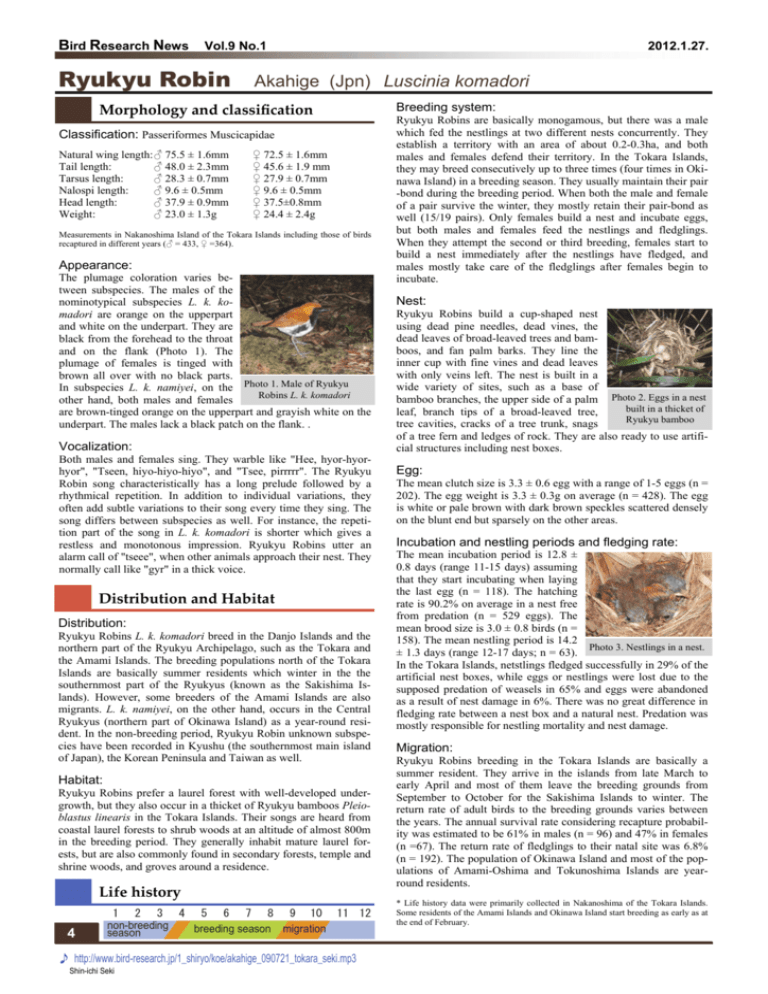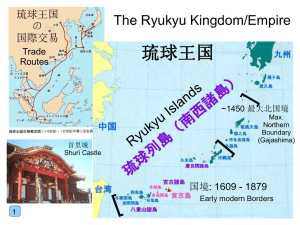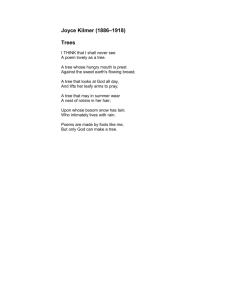Ryukyu Robin
advertisement

Bird Research News Vol.9 No.1 Ryukyu Robin Akahige (Jpn) Luscinia komadori Morphology and classification Classification: Passeriformes Muscicapidae Natural wing length: ♂ 75.5 ± 1.6mm Tail length: ♂ 48.0 ± 2.3mm Tarsus length: ♂ 28.3 ± 0.7mm Nalospi length: ♂ 9.6 ± 0.5mm Head length: ♂ 37.9 ± 0.9mm Weight: ♂ 23.0 ± 1.3g ♀ 72.5 ± 1.6mm ♀ 45.6 ± 1.9 mm ♀ 27.9 ± 0.7mm ♀ 9.6 ± 0.5mm ♀ 37.5±0.8mm ♀ 24.4 ± 2.4g Measurements in Nakanoshima Island of the Tokara Islands including those of birds recaptured in different years (♂ = 433, ♀ =364). Appearance: The plumage coloration varies between subspecies. The males of the nominotypical subspecies L. k. komadori are orange on the upperpart and white on the underpart. They are black from the forehead to the throat and on the flank (Photo 1). The plumage of females is tinged with brown all over with no black parts. In subspecies L. k. namiyei, on the Photo 1. Male of Ryukyu Robins L. k. komadori other hand, both males and females are brown-tinged orange on the upperpart and grayish white on the underpart. The males lack a black patch on the flank. . Vocalization: Both males and females sing. They warble like "Hee, hyor-hyorhyor", "Tseen, hiyo-hiyo-hiyo", and "Tsee, pirrrrr". The Ryukyu Robin song characteristically has a long prelude followed by a rhythmical repetition. In addition to individual variations, they often add subtle variations to their song every time they sing. The song differs between subspecies as well. For instance, the repetition part of the song in L. k. komadori is shorter which gives a restless and monotonous impression. Ryukyu Robins utter an alarm call of "tseee", when other animals approach their nest. They normally call like "gyr" in a thick voice. Distribution and Habitat Distribution: Ryukyu Robins L. k. komadori breed in the Danjo Islands and the northern part of the Ryukyu Archipelago, such as the Tokara and the Amami Islands. The breeding populations north of the Tokara Islands are basically summer residents which winter in the the southernmost part of the Ryukyus (known as the Sakishima Islands). However, some breeders of the Amami Islands are also migrants. L. k. namiyei, on the other hand, occurs in the Central Ryukyus (northern part of Okinawa Island) as a year-round resident. In the non-breeding period, Ryukyu Robin unknown subspecies have been recorded in Kyushu (the southernmost main island of Japan), the Korean Peninsula and Taiwan as well. Habitat: Ryukyu Robins prefer a laurel forest with well-developed undergrowth, but they also occur in a thicket of Ryukyu bamboos Pleioblastus linearis in the Tokara Islands. Their songs are heard from coastal laurel forests to shrub woods at an altitude of almost 800m in the breeding period. They generally inhabit mature laurel forests, but are also commonly found in secondary forests, temple and shrine woods, and groves around a residence. Life history 4 1 2 3 4 5 6 7 8 9 10 11 12 non-breeding breeding season migration season ♪ http://www.bird-research.jp/1_shiryo/koe/akahige_090721_tokara_seki.mp3 Shin-ichi Seki 2012.1.27. Breeding system: Ryukyu Robins are basically monogamous, but there was a male which fed the nestlings at two different nests concurrently. They establish a territory with an area of about 0.2-0.3ha, and both males and females defend their territory. In the Tokara Islands, they may breed consecutively up to three times (four times in Okinawa Island) in a breeding season. They usually maintain their pair -bond during the breeding period. When both the male and female of a pair survive the winter, they mostly retain their pair-bond as well (15/19 pairs). Only females build a nest and incubate eggs, but both males and females feed the nestlings and fledglings. When they attempt the second or third breeding, females start to build a nest immediately after the nestlings have fledged, and males mostly take care of the fledglings after females begin to incubate. Nest: Ryukyu Robins build a cup-shaped nest using dead pine needles, dead vines, the dead leaves of broad-leaved trees and bamboos, and fan palm barks. They line the inner cup with fine vines and dead leaves with only veins left. The nest is built in a wide variety of sites, such as a base of bamboo branches, the upper side of a palm Photo 2. Eggs in a nest built in a thicket of leaf, branch tips of a broad-leaved tree, Ryukyu bamboo tree cavities, cracks of a tree trunk, snags of a tree fern and ledges of rock. They are also ready to use artificial structures including nest boxes. Egg: The mean clutch size is 3.3 ± 0.6 egg with a range of 1-5 eggs (n = 202). The egg weight is 3.3 ± 0.3g on average (n = 428). The egg is white or pale brown with dark brown speckles scattered densely on the blunt end but sparsely on the other areas. Incubation and nestling periods and fledging rate: The mean incubation period is 12.8 ± 0.8 days (range 11-15 days) assuming that they start incubating when laying the last egg (n = 118). The hatching rate is 90.2% on average in a nest free from predation (n = 529 eggs). The mean brood size is 3.0 ± 0.8 birds (n = 158). The mean nestling period is 14.2 Photo 3. Nestlings in a nest. ± 1.3 days (range 12-17 days; n = 63). In the Tokara Islands, netstlings fledged successfully in 29% of the artificial nest boxes, while eggs or nestlings were lost due to the supposed predation of weasels in 65% and eggs were abandoned as a result of nest damage in 6%. There was no great difference in fledging rate between a nest box and a natural nest. Predation was mostly responsible for nestling mortality and nest damage. Migration: Ryukyu Robins breeding in the Tokara Islands are basically a summer resident. They arrive in the islands from late March to early April and most of them leave the breeding grounds from September to October for the Sakishima Islands to winter. The return rate of adult birds to the breeding grounds varies between the years. The annual survival rate considering recapture probability was estimated to be 61% in males (n = 96) and 47% in females (n =67). The return rate of fledglings to their natal site was 6.8% (n = 192). The population of Okinawa Island and most of the populations of Amami-Oshima and Tokunoshima Islands are yearround residents. * Life history data were primarily collected in Nakanoshima of the Tokara Islands. Some residents of the Amami Islands and Okinawa Island start breeding as early as at the end of February. Bird Research News Vol.9 No.1 2012.1.27. © Japan Bird Research Association Sumiyoshi 1-29-9, Fuchu, Tokyo, Japan バードリサーチ生態図鑑 Diet and foraging behavior The diet of Ryukyu Robin nestlings consists of imagos and larvae of insects (lepidoptera, diptera, hemiptera, orthoptera, blattodea, thysanura, etc.) and other invertebrates occurring on the ground and the soil surface, such as spiders, centipedes and earthworms. Although parent birds are frequently observed to peck at or dig for food on the ground, the nestling diet suggests that they also forage on trees with high frequency. They are also assumed to feed off the fruits from trees because fruit juice sometimes adheres to the corners of the bill when adult birds are captured for scientific purposes. Topics of ecology, behavior and conservation ● Phylogenetic origin of the Ryukyu Robin Since Ryukyu Robins and Japanese Robins Luscinia akahige have much in common in character and ecology, they are assumed to be sister species. Since Japanese Robins are remarkably similar in plumage coloration to European Robins Erithacus rubecula, these three species have been traditionally classified into genus Erithacus. Not a few authors have advocated the theory, however, that Ryukyu and Japanese Robins are closer to genus Luscinia because there are not only a break in distribution but also many differences in character and ecology between European Robins and the two East Asian species. The recent analyL. k. komadori sis of DNA has showed that Ryukyu L. k. namiyei Luscinia akahige Robins are closer to genus Luscinia Luscinia sibilans of East Asia, such as Rufous-tailed Luscinia cyane Robins Luscinia sibilans and Siberian Tarsiger cyanurus Luscinia calliope Blue Robins Luscinia cyane, and Phoenicurus auroreus diverged from from European Robins Erithacus rubecula in ancient times. It has been revealed, Luscinia svecica on the other hand, that genus Lusinia 0.01 genetic distance is not a single group either. An inde- Fig. 1. Maximum likelihood pendent generic name may be adoptdendrogram estimated ed to the species-group of East Asia from the base sequence including Ryukyu Robins in the fuof cytochrome-b area of mitochondrial DNA. ture. ● Variations in life history and group divergence between the island groups endurance maneuverability Ryukyu Robins vary in morphology and ecology from one island group to another. The morphology differs between the subspecies as well. L. k. komadori varies greatly in breeding and migration behavior depending on the island group. Do these variations correspond to genetic backgrounds ? Based on the mtDNA sequence data, each of the two subspecies formed genetically distinctive clade, which diverged more than several hundred thousand years ago. In addition, three distinctive subgroups of populations were identified within L. k. komadori by population genetic analysis: sedentary Tokunoshima and Ohshima groups and migratory High Low Tokara group. When the wingtip shape, that is a highly heritable trait and well associated with migratory habit, was compared, L. k. komadori had significantly more pointed wing than that of Low High the southern sedentary L. k. namiyei. The difference was not so apparent be- Photo. 4. Difference in wing shape between L. tween the sedentary and migratory k. komadori of the groups within L. k. komadori, suggestTokara Islands (above) ing that this northern subspecies has and L. k. namiyei differentiated as primarily a migratory (below). lineage from southern sedentary lineage L. k. namiyei. Then, sedentary populations (of Tokunoshima and Amami-Ohshima Islands) arose recently in the migratory subspecies (L. k. komadori), which triggered another differentiation in the subspecies. ● Migration of Ryukyu Robins Ryukyu Robins winter in a considerable number in the Sakishima Islands. They use a wide variety of woodlands as a wintering site, ranging from the primeval forests of Iriomotejima Island to the shrine groves of small islands consisting primarily of farmland, such as Kuroshima Island. A limited number of Ryukyu Robins have formally been observed in the Sakishima Islands probably because they rarely sing or come out into an open habitat in the wintering grounds. The analysis of mitochondrial DNA genotypes of birds captured in the Sakishima Islands showed that 87% of the wintering birds came from the Tokara Islands, 8% Amami-Oshima Island and 5% Tokunoshima Island (n = 37). Although the populations of Tokunoshima and Amami-Oshima Islands were assumed to be sedentary until then, it was revealed that they included birds which migrated to the Sakishima Islands. It is still unknown what types of birds migrate or stay in the breeding grounds. Incidentally, there is no record of Ryukyu Robins from the Sakishima Islands in the breeding period. It is highly unlikely, therefore, that the breeding population of the Sakishima Islands that has been once described as L. k. subrufus actually occurs in those islands. Literature Kawaji N. & Higuchi H. 1989. Distribution and status of the Ryukyu Robin Erithacus komadori. J. Yamashina Inst. Ornithol. 21:224-233. Sangster G., Alstrom P., Forsmark E. & Olsson U. 2010. Multi-locus phylogenetic analysis of Old World chats and flycatchers reveals extensive paraphyly at family, subfamily and genus level (Aves: Muscicapidae). Mol. Phylogenet. Evol. 57: 380-92. Seki S-I. 2006. The origin of the East Asian Erithacus robin, Erithacus komadori, inferred from cytochrome b sequence data. Mol. Phylogenet. Evol. 39: 899-905. Seki S-I. 2002. Estimating the survival rate and dispersal distance of the Ryukyu robin, Erithacus komadori. Kyushu J. For. Res. 55:171-172. [J] Seki S-I. 2009. Population trends and molecular phylogenetic position of the isolated Ryukyu Robin Erithacus komadori on the Danjo Islands, Japan. Jap. J. Ornithol. 58:18-27. [J+E] Seki S-I. 2010. Recent status of the Ryukyu robin Erithacus komadori in the outlying habitats (II): Yaku-shima and Tanega-shima in the Ohsumi Islands. Kyushu J. For. Res. 63: 95-96. [J] Seki S-I. & Ogura T. 2007. Breeding origins of migrating Ryukyu Robins Erithacus komadori inferred from mitochondrial control region sequences. Ornithol. Sci. 6:21-27. Seki S-I., Sakanashi M., Kawaji N. & Kotaka N. 2007. Phylogeography of the Ryukyu Robin (Erithacus komadori) population subdivision in land-bridge islands in relation to the shift in migratory habit. Mol. Ecol. 16: 101-113. Seki S-I., Tokorozaki S., Mizoguchi F., Takagi S., Nakamura N. & Crystal F. 2011. Avifauna of the Tokara Islands, northern Ryukyu Archipelago. Bulletin of FFPRI 10:183-229 [J+E] Languages of literature cited other than English: [J] in Japanese, [J+E] in Japanese with English summary. Author Shin-ichi SEKI Forestry and Forest Products Research Institute The Tokara Islands, my major research field, is a wonderful place for ornithologists, full of island endemics. It is almost 18 years since I first started studying the ecology of the Ryukyu Robin there. Nevertheless, it was a difficult work to write this small article. The research on this superb singer is still on its way, and I usually experience something new every year. I am looking forward to rewrite this guide in the near feature based on such new findings. seki@ffpri.affrc.go.jp 5








